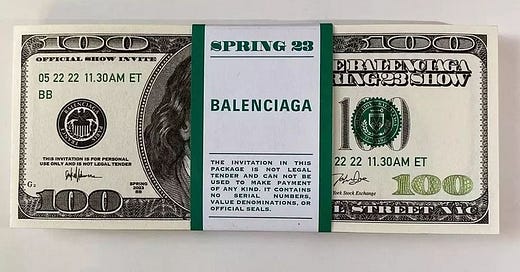Welcome to the Sociology of Business. Sociology of Business now offers a paid membership program. Paid options are for the members of this community who want to be the first to access everything from Web3 brand-building to the new business models and emerging creative formats. Since its inception, the Sociology of Business has been the source code for many other analyses, strategies and brand-building approaches. Members will now have the front-row seat. If you are not yet subscribed, join the community by subscribing below and joining the Sociology of Business Discord. You can find my book, The Business of Aspiration on Amazon and you can find me on Instagram and Twitter. For those new here, my last analysis detailed my experience of turning a legacy brand around.
Aspirational markets used to refer exclusively to luxury markets (high-end products, services, and experiences), but now the definition expanded to (almost all) B2C categories. Healthcare, exercise, food, entertainment, even CPG (e.g. Moon Juice, Perky Jerky) are aspirational. “Aspirational” consumption is a consumption that reflects one’s taste, knowledge, identity and social status.
A feature of aspirational markets is that products, services, and money are just one kind of the value that brands create - economic value. Brand growth doesn’t come just from how many products it creates or how much money it has, but from its social and cultural output.
When aspiration moved from accumulation of tangible assets as the status signaling mechanism towards accumulation of intangibles - like creativity, knowledge, belonging, curation, and aesthetics - companies started moving from manufacturing products to manufacturing content, curation, communities and collaborations.
These intangibles are traded through the five currencies of aspirational markets: images, stories, membership, collectibles and taste. They have the power to transform non-culture into culture (an item becomes more significant and valuable if it is part of a collection that has a history and a story), which makes them a powerful cultural engine. Aspirational currencies are also a great business model: their focus is not on volume, but on value of the brand capital.
Creativity. In aspirational markets, the goal is not to create anything new, but to remix, re-contextualize, and re-interpret existing ideas, trends, styles and looks by making them slightly different than before. The already existing things are questioned, commented on, and criticized. Originality is in dot-connecting. The best example is MSCHF, a creative collective, that created Wavy Baby x Tyga sneakers, Nike’s filled with Holy Water, Birkenstocks made of Birkin bags, and 999 fake and one real Andy Warhol. There’s a good reason for this sort of creativity: compressed trend cycles force brands to constantly come up with new stuff. Consumers expect physical things to move at speed of the Instagram feed. A quick solve for this situation is to riff off already popular and familiar stuff. Cue in collaborations.
Knowledge. There is a number of ways to assign value to something. On the most basic, economic level, products perform a function and are priced based on their features (materials, labor). Their value is a combination of this performance and price. Another way of evaluation is to look not only at an item’s price, but to know about its unique history and heritage. To voir (see) is to savoir (know). Cue in vintage markets.
Aesthetics. Aesthetic innovation infuses taste and meaning into the ordinary consumption. The most mundane products - like a lip gloss or a toothpaste - come with a considered color palette, details and logos. “Good business is good art,” said Andy Warhol, and this may as well be the modern branding’s mantra, fed by the massive offering of Instagram inspiration. Late Virgil Abloh transformed mundane objects (rugs, water bottles, t-shirts) into works of art through quotation marks. Before him, Surrealists did the same. Today, shows like Bridalplasty, Million Dollar Decorators, or 100% Hotter tell consumers how to redesign their face, house and life. Aesthetic innovation gives competitive edge to consumers and brands alike: innovativeness is not in having superior products or new technology, but in a signature recognizable aesthetics. Successful modern brands create cult objects - GOOP’s Jade Egg, Tesla Tequila, Nike Jordan 1, Bored Apes - that combine the aesthetic experience, identity building and social display.

Curation. “Curare” in Latin means to care. A curator was a caretaker of objects. Curation is also about curiosity. Today, curation is the preferential strategy for brand differentiation, relevance, and equity gain. With a good reason: under pressure of newness, brands curate their old items, ideas, and collections, and give it renewed meaning and purpose in consumers’ eyes. Brand benefits are also substantial: curation preserves cultural heritage by interpreting it for the present and by making it relevant for those who never heard of it, constantly refreshing the brand. Curation also contextualizes products within a specific time and point of view. But modern curation is a far cry from the art curators of lore, who were revered and feared, and who could make or break an artist. Yayoi Kusama famously threw herself out of the window when she couldn’t make it in the New York art scene, which in the '70s was stiflingly white and male. Today’s curation is with a lowercase “c,” open to anyone.
Belonging. In the modern aspirational economy, brand affinity is created not economically, but socially. A lot of sneaker heads wait in line all night to score a coveted item don’t do it so they can flip it; they do it from the badge value, belonging and bragging rights. The keywords of the modern brand affinity are not prestige and exclusivity but identity and belonging. There is a pure pleasure in the intimacy of consuming together, along with enjoying status within a community and membership benefits: thanks to a membership in their community, a hype beast gets access to new product drops and events. In the modern aspirational economy, consumers are members, investors, and collectors.
What do these new ways of showing off mean for brands? Brands are not relevant if they don’t have the aspirational power. To achieve and maintain the aspirational power, modern brand strategy shifts from product benefits to the story, and makes it imperative for brands to start thinking of themselves as part of culture.
To make themselves part of the culture, brands need to start trading the in these five currencies:
This analysis is for paid subscribers. Subscribe to read.








